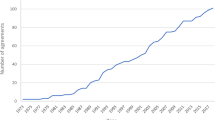Abstract
Since the late nineteenth century, the presence of an independent and meritocratic bureaucracy has been posited as an advantage for effective bureaucratic behaviour and a means of limiting patrimonial networks and corruption, among other benefits. There is little consensus on how the features of an independent and meritocratic bureaucracy should be measured across countries, however, and broad empirical studies are therefore rare. What is more, the few such studies that exist have advanced measures which are constructed exclusively on expert surveys. Although these have indeed contributed to the knowledge in the field, the data on which they are built come with problems. This paper proposes a set of novel measures that complement existing measures and thus fill important gaps in this burgeoning literature. The measures we present are not based on expert assessments but on perceptions of public sector employees’ and citizens’. We create two measures—that can be combined into one—from a recent survey (2013) of over 85,000 citizens in 24 European countries. One is purely based on the assessments from public sector employees’ and the other is based on perceptions of citizens working outside the public sector. The paper also discusses the survey and explores the external validity of the measures provided here, showing correlations with alternative measures based on expert opinions, as well as variables from the literature that we would expect to correlate highly with a meritocratic bureaucracy.










Similar content being viewed by others
Notes
Funding for this project comes from the Seventh Framework Programme for Research and Development of the European Union, project number 290529. This research project is part of ANTICORRP, (http://anticorrp.eu/ ).
NUTS stands for ‘Nomenclature of territorial units for statistics’ and is made up of statistical regions for the EU and other European countries. For further information, see: http://ec.europa.eu/eurostat/web/nuts/overview
The sample of countries and corresponding NUTs level and regions are reported in Appendix 1.
By ‘politically relevant’ region we mean one that has an elected parliament and exercises policy control over several areas, such as health care and education. Regions that are ‘politically relevant’ in this sample include: all regions in Italy, Germany, Spain, Denmark, Belgium, Poland, France and Austria; three regions from the United Kingdom (Scotland, Wales and Northern Ireland); and two from Portugal (Açores and Madeira).
Summary statistics and sources for data used throughout this section are found in Appendix 2
In general, Turkey is an outlier in our sample, and its exclusion noticeably increases almost all correlations in Table 1.
References
Adcock, R., & Collier, D. (2001). Measurement validity: A shared standard for qualitative and quantitative research. The American Political Science Review, 95(3), 529–546.
Aghion, P., & Tirole, J. (1997). Formal and Real Authority in Organizations”. Journal of Political Economy, 105, 1–29.
Alesina, A., & Tabellini, G. (2007). “Bureaucrats or Politicians? Part I: A Single Policy Task”. American Economic Review, 97, 169–179.
Charron, N., Dijkstra, L., & Lapuente, V. (2015). Mapping the Regional Divide in Europe: A Measure for Assessing Quality of Government in 206 European Regions”. Social Indicators Research, 122(2), 315–346.
Charron, N., Dijkstra, L., & Lapuente, V. (2014). Regional Governance Matters: Quality of Government within European Union Member States”. Regional Studies, 48(1), 68–90.
Charron, N., Lapuente, V., & Rothstein, B. (2013). Quality of Government and Corruption from a European Perspective: A Comparative Study of Good Government in EU Regions. Cheltenham: Elgar.
Cingranelli, J., & Richards, D. L. (2013). Ciri dataset 2008. ciri.binghamton.edu/index.asp. Accessed Sept 2015.
Dahlström, C., Lapuente, V. (2014). “Organizing Leviathan”. Paper presented at the 72nd annual Midwest Political Science Association Conference, Chicago.
Dahlström, C., Lapuente, V., & Teorell, J. (2012). The Merit of Meritocratization Politics, Bureaucracy, and the Institutional Deterrents of Corruption”. Political Research Quarterly, 65(3), 656–668.
Dahlström, C., Teorell, J., Dahlberg, S., Hartmann, F., Lindberg, A., & Nistotskaya, M. (2015). The QoG Expert Survey Dataset II. University of Gothenburg: The Quality of Government Institute.
Dollar, D. (1992). Outward-Oriented Developing Economies Really Do Grow More Rapidly: Evidence from 95 LDCs, 1976-1985. Economic Development and Cultural Change, 40(3), 523–544.
Evans, P., & Rauch, J. (1999). Bureaucracy and Growth: A Cross-National Analysis of the Effects of ‘Weberian’ State Structures on Economic Growth. American Sociological Review, 64(5), 748–65.
Frankel, J. A. & Romer, D. (1999). Does Trade Cause Growth? The American Economic Review, 89(3), 379–399.
Frant, H. (1993). Rules and Governance in the Public Sector: The Case of Civil Service. American Journal of Political Science, 37(4), 990–1007.
Galbraith, J., & Garcilazo, E. (2005). Pay Inequality in Europe 1995-2000: convergence between countries and stability inside. The European Journal of Comparative Economics, 2(2), 139.
Henderson, J., Hulme, D., Jalilian, H., & Phillips, R. (2007). Bureaucratic Effects: ‘Weberian’ State Agenciesand Poverty Reduction”. Sociology, 41(3), 515–532.
Horn, M. (1995). The Political Economy of Public Administration: Institutional Choice in the Public Sector. New York: Cambridge University Press.
Jacobs, R., Goddard, M., Smith, P. (2006). Public services: are composite measures a robust reflection of performance in the public sector?. University of York, Centre for Health Economics Research Paper.
Krause, G., Lewis, D., & Douglas, J. (2006). Political Appointments, Civil Service Systems, and Bureaucratic Competence: Organizational Balancing and Executive Branch Revenue Forecasts in the American States”. American Journal of Political Science, 50(3), 770–787.
Krugman, P. (1991). Geography and Trade. Cambridge: MIT Press.
Kuznets, S. (1955). Economic growth and income inequality”. American Economic Review, 45(1), 1–28.
Lewis, D. (2008). The Politics of Presidential Appointments: Political Control and Bureaucratic Performance. Princeton: Princeton University Press.
Miller, G. (2000). Above Politics: Credible Commitment and Efficiency in the Design of Public Agencies”. Journal of Public Administration Research and Theory, 10(2), 289–3.
Myrdal, G. (1957). Economic Theory and Underdeveloped Regions. Methuen: London: University Paperbacks.
Northcote, S., & Trevelyan, C. (1853). Report on the Organization of the Permanent Civil Service. London: House of Commons.
Olsen, J. P. (2005). Maybe it is Time to Rediscover Bureaucracy”. Journal of Public Administration Research and Theory, 16(1), 1–24.
Parrado, S. (2000). “The Development and Current Features of the Spanish Civil Service System”. In H. Bekke & Frits van der Meer (eds.). Civil Service Systems in Western Europe. Bodmin: MPG Books.
Persson, T., & Tabellini, G. (2005). The Economic Effects of Constitutions. Munich Lectures in Economics. Cambridge: The MIT Press.
Peters, B. G., & Pierre, J. (Eds.). (2001). Politicians, bureaucrats and administrative reform. London: Routledge.
Peters, B. G., & Pierre, J. (Eds.). (2004). Politicization of the Civil Service in Comparative Perspective. London: Routledge.
Pollitt, C. (2011). Moderation in all thing: international comparisons of governance quality”. Financial Accountability and Management, 27(4), 437–457.
Prud'homme, R. (1995). The dangers of decentralization”. The World Bank Observer, 10(2), 201–220.
Rauch, J., & Evans, P. (2000). Bureaucratic structure and bureaucratic performance in less developed countries. Journal of Public Economics, 75(1), 49–71.
Rokkan, S. (1970). Citizens, Elections, Parties: Approaches to the Comparative Study of the Process of Development. New York: David McKay.
Rothstein, B. (2011). The Quality of Government: Corruption, Social Trust and Inequality in International Perspective. Chicago: University of Chicago Press.
Rothstein, B., & Teorell, J. (2012). Defining and measuring quality of government. In S. Holmberg & B. Rothstein (Eds.). Good Government: The Relevance Of Political Science. Cheltenham: Edward Elgar.
Silberman, B. (1993). Cages of Reason: The Rise of the Rational State in France, Japan, the United States, and Great Britain. Chicago: Chicago University Press.
Snyder, R. (2001). Scaling down: The subnational comparative method”. Studies in Comparative International Development, 36(1), 93–110.
Sotiropoulos, D. (2004). Two Faces of Politicization of the Civil Service: The Case of Contemporary Greece”. In G. Peters & P. Jon (Eds.), Politicization of the Civil Service in Comparative Perspective. London: The Quest for Control.
Sundström, A. (2013). Women’s local political representation within 30 European countries. University of Gothenburg, QoG Working Paper Series, 2013:18.
Tabellini, G. (2008). Institutions and Culture”. Journal of the European Economic Association, 6, 255–294.
Teorell, J, Charron, N,. Dahlberg, S,. Holmberg, S,. Rothstein, B,. Sundin, P. & Svensson. R. (2013). The Quality of Government Dataset, version 15May13. University of Gothenburg: The Quality of Government Institute, http://www.qog.pol.gu.se.
Teorell, J., Dahlström, C., & Dahlberg,.S. (2011). The QoG Expert Survey Dataset. University of Gothenburg: The Quality of Government Institute.
Treisman, D. (2007). What Have We Learned About the Causes of Corruption from Ten Years of Cross-National Empirical Research?”. Annual Review of Political Science, 10, 211–44.
Weber, Max 1978[1922]. Economy and Society. Berkeley: University of California Press.
Wilson, W. (1887). Study of Administration. Political Science Quarterly, 2, 197–222.
Williamson, J. (1965). Regional Inequality and the Process of National Development: A Description of the Patterns”. Economic Development and Cultural Change, 13(4), 3–45.
Author information
Authors and Affiliations
Corresponding author
Rights and permissions
About this article
Cite this article
Charron, N., Dahlström, C. & Lapuente, V. Measuring Meritocracy in the Public Sector in Europe: a New National and Sub-National Indicator. Eur J Crim Policy Res 22, 499–523 (2016). https://doi.org/10.1007/s10610-016-9307-0
Published:
Issue Date:
DOI: https://doi.org/10.1007/s10610-016-9307-0




